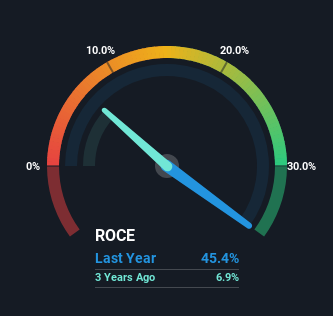- Israel
- /
- Aerospace & Defense
- /
- TASE:BSEN
Investors Should Be Encouraged By Bet Shemesh Engines Holdings (1997)'s (TLV:BSEN) Returns On Capital

To find a multi-bagger stock, what are the underlying trends we should look for in a business? One common approach is to try and find a company with returns on capital employed (ROCE) that are increasing, in conjunction with a growing amount of capital employed. This shows us that it's a compounding machine, able to continually reinvest its earnings back into the business and generate higher returns. With that in mind, the ROCE of Bet Shemesh Engines Holdings (1997) (TLV:BSEN) looks great, so lets see what the trend can tell us.
Return On Capital Employed (ROCE): What Is It?
If you haven't worked with ROCE before, it measures the 'return' (pre-tax profit) a company generates from capital employed in its business. To calculate this metric for Bet Shemesh Engines Holdings (1997), this is the formula:
Return on Capital Employed = Earnings Before Interest and Tax (EBIT) ÷ (Total Assets - Current Liabilities)
0.45 = US$84m ÷ (US$273m - US$87m) (Based on the trailing twelve months to September 2023).
Therefore, Bet Shemesh Engines Holdings (1997) has an ROCE of 45%. That's a fantastic return and not only that, it outpaces the average of 12% earned by companies in a similar industry.
See our latest analysis for Bet Shemesh Engines Holdings (1997)

While the past is not representative of the future, it can be helpful to know how a company has performed historically, which is why we have this chart above. If you're interested in investigating Bet Shemesh Engines Holdings (1997)'s past further, check out this free graph covering Bet Shemesh Engines Holdings (1997)'s past earnings, revenue and cash flow.
The Trend Of ROCE
Investors would be pleased with what's happening at Bet Shemesh Engines Holdings (1997). Over the last five years, returns on capital employed have risen substantially to 45%. The company is effectively making more money per dollar of capital used, and it's worth noting that the amount of capital has increased too, by 48%. This can indicate that there's plenty of opportunities to invest capital internally and at ever higher rates, a combination that's common among multi-baggers.
For the record though, there was a noticeable increase in the company's current liabilities over the period, so we would attribute some of the ROCE growth to that. Effectively this means that suppliers or short-term creditors are now funding 32% of the business, which is more than it was five years ago. It's worth keeping an eye on this because as the percentage of current liabilities to total assets increases, some aspects of risk also increase.
The Bottom Line
In summary, it's great to see that Bet Shemesh Engines Holdings (1997) can compound returns by consistently reinvesting capital at increasing rates of return, because these are some of the key ingredients of those highly sought after multi-baggers. And investors seem to expect more of this going forward, since the stock has rewarded shareholders with a 78% return over the last five years. Therefore, we think it would be worth your time to check if these trends are going to continue.
One final note, you should learn about the 2 warning signs we've spotted with Bet Shemesh Engines Holdings (1997) (including 1 which makes us a bit uncomfortable) .
If you want to search for more stocks that have been earning high returns, check out this free list of stocks with solid balance sheets that are also earning high returns on equity.
If you're looking to trade Bet Shemesh Engines Holdings (1997), open an account with the lowest-cost platform trusted by professionals, Interactive Brokers.
With clients in over 200 countries and territories, and access to 160 markets, IBKR lets you trade stocks, options, futures, forex, bonds and funds from a single integrated account.
Enjoy no hidden fees, no account minimums, and FX conversion rates as low as 0.03%, far better than what most brokers offer.
Sponsored ContentValuation is complex, but we're here to simplify it.
Discover if Bet Shemesh Engines Holdings (1997) might be undervalued or overvalued with our detailed analysis, featuring fair value estimates, potential risks, dividends, insider trades, and its financial condition.
Access Free AnalysisHave feedback on this article? Concerned about the content? Get in touch with us directly. Alternatively, email editorial-team (at) simplywallst.com.
This article by Simply Wall St is general in nature. We provide commentary based on historical data and analyst forecasts only using an unbiased methodology and our articles are not intended to be financial advice. It does not constitute a recommendation to buy or sell any stock, and does not take account of your objectives, or your financial situation. We aim to bring you long-term focused analysis driven by fundamental data. Note that our analysis may not factor in the latest price-sensitive company announcements or qualitative material. Simply Wall St has no position in any stocks mentioned.
About TASE:BSEN
Bet Shemesh Engines Holdings (1997)
Manufactures and sells jet engine parts in Israel.
Flawless balance sheet and good value.
Market Insights
Community Narratives




